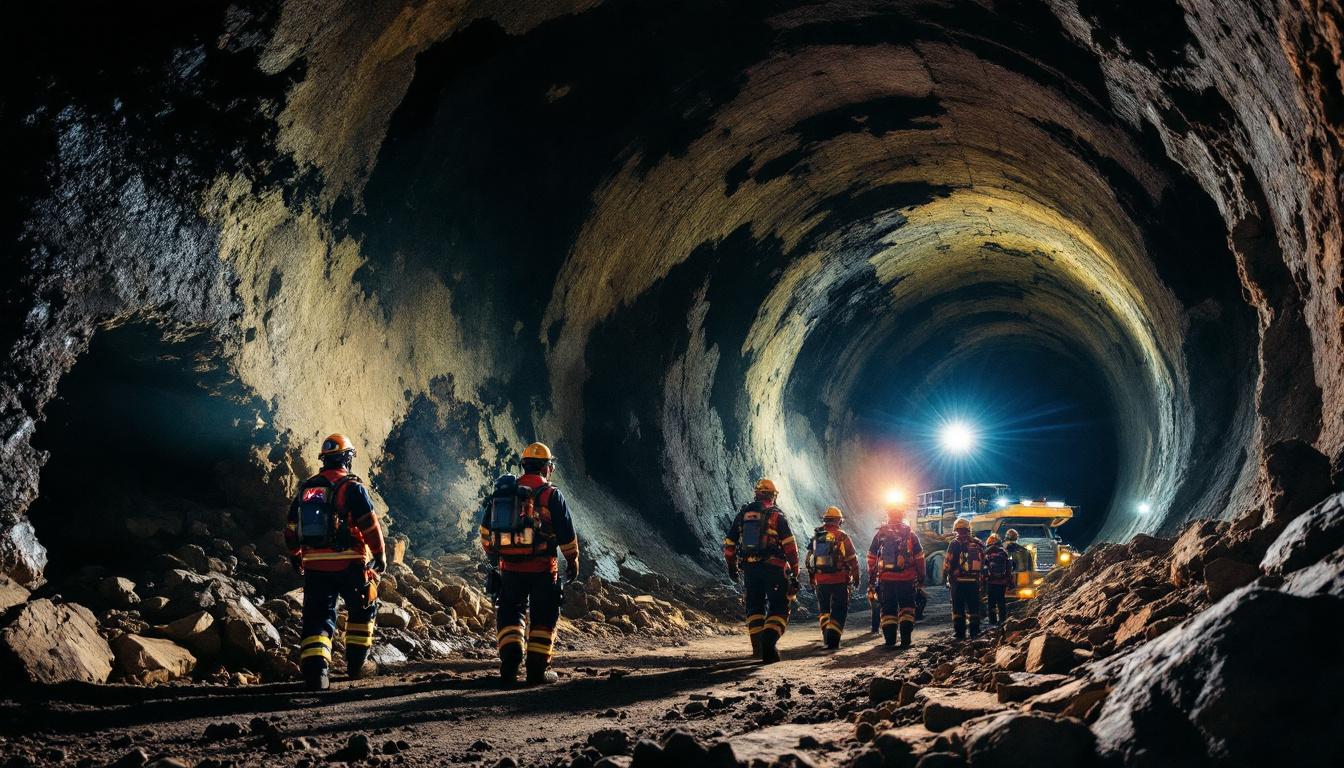What Are Critical Minerals and Metals?
Definition in the South African Context
Critical minerals and metals in South Africa are defined not solely by global supply risks but by their capacity to drive domestic economic value, support industrial development, and enable the energy transition. Unlike the European Union or United States, which emphasize supply security, South Africa's approach integrates mineral beneficiation in South Africa potential and downstream manufacturing opportunities. For example, platinum group metals (PGMs) are deemed critical not only for their export value but for their application in hydrogen fuel cells and renewable energy systems. This dual focus on economic and technological relevance ensures alignment with national priorities like job creation and industrial diversification.
Criteria for Classification
The DMPR employs a multi-criteria framework to classify minerals:
Economic Contribution: Minerals contributing over 5% to GDP or 10% to export earnings, such as coal (7.2% of 2023 exports).
Strategic Industrial Value: Resources like manganese, essential for steel production and battery alloys.
Beneficiation Potential: Chromium's use in stainless steel manufacturing exemplifies high local value addition.
Supply Chain Resilience: South Africa holds 80% of global platinum reserves, reducing dependency on external suppliers.
Green Transition Relevance: Vanadium's role in redox flow batteries for energy storage underscores its criticality.
Why South Africa Needs a Critical Minerals Strategy
Global Mineral Supply Chain Dynamics
The global demand for critical minerals for energy transition is projected to quadruple by 2040, driven by renewable energy and electric vehicle (EV) adoption. South Africa's strategy responds to geopolitical shifts, such as the EU's Critical Raw Materials Act and the U.S. Inflation Reduction Act, which incentivize localized supply chains. By securing partnerships with industrialized nations, South Africa aims to avoid the "resource curse" and transition from raw material exporter to technology supplier. For instance, PGMs account for 70% of global production, yet only 15% are currently processed domestically.
Economic Growth Opportunities
Mining contributes 8% to South Africa's GDP, but the strategy targets a 12% share by 2030 through:
Exploration Revival: A proposed 50% tax incentive for greenfield exploration projects.
Processing Expansion: The Boegoebaai manganese processing hub, set to produce 1.2 million tons annually by 2027.
Export Diversification: Shifting from raw chrome exports (95% of production) to ferrochrome, which commands triple the value.
Energy Transition Imperatives
South Africa's coal-dominated energy mix (85% of electricity) necessitates a phased transition. The strategy prioritizes PGMs for hydrogen electrolyzers and manganese for EV batteries, aligning with the Just Energy Transition Investment Plan (JET-IP). Projects like the Hydrogen Valley corridor aim to create 20,000 jobs by 2030 through PGM-driven hydrogen ecosystems.
Key Elements of South Africa's Critical Minerals Strategy
High-Critical Minerals Identification
The DMPR's classification of five high-critical minerals reflects their dominance in export earnings and industrial applications:
Platinum: 140 tons produced annually, supporting 500,000 jobs.
Manganese: 7.4 million tons mined in 2023, with 60% exported as ore.
Iron-Ore: 78 million tons produced, primarily for China's steel sector.
Coal: 250 million tons annual production, though transitioning to metallurgical uses.
Chrome Ore: 18 million tons mined, with R300 billion in untapped beneficiation potential.
Moderate to High Criticality Minerals
Gold, vanadium, and rare earth elements (REEs) are prioritized for niche applications:
Gold: 100 tons produced annually, with potential in electronics and medical tech.
Vanadium: 9,000 tons mined, critical for grid-scale energy storage.
REEs: The Steenkampskraal mine holds 80,000 tons of monazite, a key REE source.
Five Strategic Pillars
1. Enhanced Exploration
The strategy allocates R2.5 billion to modernize geological surveys, including airborne electromagnetic mapping of the Bushveld Complex. Joint ventures with firms like De Beers aim to expand exploration in underprospected regions.
2. Research and Development Focus
Mintek's R&D hub in Johannesburg will pioneer hydrometallurgical techniques for PGM recovery, targeting 95% efficiency by 2026. Collaborative projects with MIT focus on reducing rare earth processing costs by 40%.
3. Local Processing and Beneficiation
The Musina-Makhado Special Economic Zone (SEZ) will host a R45 billion stainless steel plant, processing 2 million tons of chrome annually. Tax rebates of 15% are offered for processing equipment imports.
4. Infrastructure Development
Transnet's R20 billion rail upgrade aims to reduce manganese export costs by 30% through the Northern Corridor. Eskom's dedicated 500 MW renewable energy cluster for mines will lower processing costs.
5. Strategic Partnerships
The BRICS Critical Minerals Alliance, launched in 2024, facilitates technology transfer, with China investing R15 billion in South African lithium processing facilities.
Implementation Roadmap and Timelines
Short-Term Priorities (2025–2026)
Geological Surveys: High-resolution mapping of the Waterberg coal basin.
Critical Minerals Council: Established in Q3 2025, chaired by Minister Gwede Mantashe.
Skills Development: 10,000 artisans trained in mineral processing via TVET colleges.
Medium-Term Goals (2027–2029)
Processing Facilities: The Coega PGMs refinery, producing 50 tons/year of catalytic converters.
Transport Upgrades: The Sishen-Saldanha rail line electrification for iron-ore exports.
Long-Term Vision (2030–2040)
Value Chain Integration: From PGM mining to fuel cell manufacturing in Gauteng.
Global Leadership: 30% share in global manganese processing by 2040.
Role of Key Stakeholders
Government Agencies
The DMPR coordinates cross-departmental committees, such as the Intergovernmental Committee on Mineral Beneficiation (ICMB), to align policies. The National Treasury's R&D tax incentive (Section 11D) offers 150% deductions for mining innovation trends.
Research Organizations
Mintek's pilot plant in Randfontein tests bioleaching for low-grade copper ores, reducing water use by 70%. The Council for Geoscience (CGS) partners with NASA on satellite-based mineral detection.
Private Sector
Anglo American's Mogalakwena mine will triple PGM processing capacity by 2027, while Sibanye-Stillwater invests R10 billion in lithium-ion battery recycling.
Academic Institutions
The University of Pretoria's Rare Earth Innovation Centre (REIC) develops solvent extraction techniques, while Wits University's Digital Mining Hub pioneers AI in mining operations.
Economic Impact Analysis
Job Creation Potential
The strategy envisions 200,000 new jobs by 2030:
Direct Mining: 50,000 roles in expanded PGMs and manganese operations.
Processing: 70,000 positions in SEZs like Richards Bay.
Indirect: 80,000 jobs in equipment manufacturing and logistics.
Export Revenue Enhancement
Value-added exports could reach R450 billion annually by 2030:
Ferrochrome: From R60 billion (2023) to R150 billion.
PGMs: From R300 billion to R500 billion through catalytic converter exports.
Industrial Development Benefits
The strategy's downstream focus supports:
Green Tech: Hydrogen South Africa (HySA) aims to produce 500,000 fuel cells annually by 2030.
Advanced Manufacturing: Local production of manganese-rich aluminum alloys for aerospace.
Challenges and Risk Mitigation
Infrastructure Constraints
Eskom's load-shedding costs miners R25 billion annually. The strategy permits self-generation, with 2 GW of solar capacity planned for mines by 2026.
Skills Gaps
A 2023 Minerals Council report notes a 40% shortfall in metallurgical engineers. Partnerships with German institutions will train 5,000 specialists by 2027.
Environmental Considerations
The Green Metallurgy Initiative mandates 30% water recycling in processing plants. Circular economy pilots recover 90% of cobalt from EV batteries.
Market Volatility
The Mineral Price Stabilization Fund, capitalized at R15 billion, buffers against commodity swings. Long-term contracts with the EU cover 50% of PGM exports.
How Does South Africa's Strategy Compare Globally?
Comparison with Major Mining Nations
Australia: Focuses on lithium and rare earths, lacking South Africa's beneficiation emphasis.
Canada: Targets cobalt and graphite, but with lower PGM reserves.
Chile: Lithium-centric, without South Africa's diversified mineral base.
Competitive Advantages
Resource Wealth: 90% of global platinum reserves.
Established Infrastructure: 3,000 km of dedicated mineral rail lines.
Research Capacity: Mintek's 80-year legacy in extractive metallurgy.
International Cooperation Opportunities
The Africa Continental Free Trade Area (AfCFTA) enables tariff-free mineral trade, while the EU's Global Gateway Initiative funds REE processing plants.
Future Outlook and Adaptability
Monitoring and Evaluation Framework
The DMPR's biannual Critical Minerals Index tracks 15 KPIs, including export diversification and R&D investment. Independent audits by PwC ensure transparency.
Adaptation to Market Changes
Flexibility mechanisms allow reclassification of minerals, as seen with lithium's elevation to high-critical status in 2024.
Innovation Pipeline
The R1 billion Innovation Fund supports startups in bio-mining and carbon capture, with 30 projects funded since 2023.
Conclusion
South Africa's Critical Minerals and Metals Strategy marks a paradigm shift from resource extraction to value chain dominance. By harnessing its mineral wealth through targeted R&D, infrastructure upgrades, and global partnerships, the country is poised to become a hub for green technology and high-value manufacturing. Success hinges on overcoming infrastructure bottlenecks, upskilling the workforce, and maintaining environmental stewardship. As global mining landscape evolves, South Africa's strategic focus on beneficiation and sustainability offers a blueprint for resource-rich economies worldwide, as highlighted in the South African Critical Minerals Strategy.
Further Exploration:
For ongoing updates on South Africa's mineral strategy, consult Mining Weekly's dedicated portal on critical minerals and the DMPR's quarterly implementation reports.
Looking to Capitalise on the Next Major Mineral Discovery?
Stay ahead of the market with Discovery Alert's proprietary Discovery IQ model, which instantly notifies investors about significant ASX mineral discoveries, transforming complex data into actionable insights for both short-term traders and long-term investors. Understand why major mineral discoveries can generate substantial returns by visiting Discovery Alert's dedicated discoveries page and begin your 30-day free trial today.




